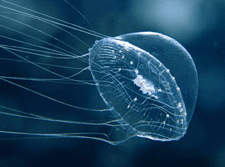
Aequorea sp. 1
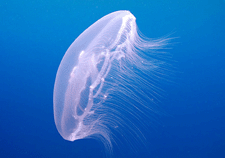
Aurelia sp. 1
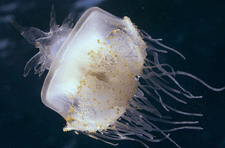
Cephea cephea

Crambione mastigophora

Mastigias papua
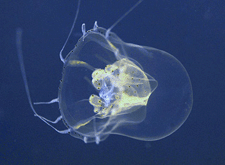
Merga violacea
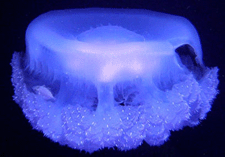
Netrostoma setouchianum
Jellyfish belong to the animal phylum that also includes corals and anemones. There are a number of species that can be found at Kwaj, not all of which are shown here. Their populations often are sporadic; sometimes they form large swarms or "smacks" so thick it is hard to swim between them, and other times individuals can hardly be found. While the classic jellyfish pulses through open water, many also pass through a stage where they are attached to the bottom, much like a coral sort of animal. Those that undergo what is sometimes called an "alternation of generations" have an interesting life cycle. Adult jellyfish produce eggs or sperm. Males release sperm into the water through their mouths, and fertilization often takes place on or in the female's body. Developing larvae are released and swim about like tiny flatworms in the plankton, and when ready, settle to the bottom to form a soft but coral-like polypoid benthic animal. As these grow, they release tiny jellies that grow into the jellyfish that again produce eggs and sperm. Not all jellies develop this way, however. Like their coral and anemone relatives, jellyfish possess stinging cells called nematocysts whose stings in humans vary in intensity from very mild to very painful.
Measurements were rarely taken in the field and animals were not collected, so any sizes given are usually very rough eyeball estimates of the larger individuals, often based on distant memories, and are provided only as a general guideline of what to look for. Sizes refer to diameter of the bell.
We welcome corrections or comments at uwkwaj@yahoo.com. Clicking on the thumbnails below brings up a page for that species.
 Aequorea sp. 1 |
||
 Aurelia sp. 1 |
 Cephea cephea |
|
 Crambione mastigophora |
 Mastigias papua |
 Merga violacea |
 Netrostoma setouchianum |
||
Box Jellies belong to a separate major group within the jellyfish-like animals, and are also distantly related to corals and anemones. These jellies, also called cubomedusae because the four tentacles (sometimes branched) that extend from the underside of the bell are sort of at the four corners of a square, tend to have extremely powerful nematocysts with virulent venom. One species commonly called the sea wasp along with a few other species have apparently caused fatalities in humans. Fortunately the most dangerous sea wasp does not appear to occur at Kwaj, but at least some of those we do have can produce very painful stings.
 Copula sivickisi |
Siphonophores are animals related to, but are not quite jellyfish. Some, like the floating Portuguese man-o-war, have potent nematocysts and can deliver painful stings.
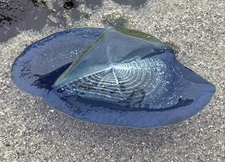 Velella velella |
||
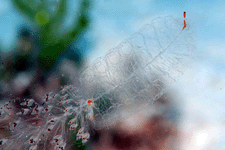 Siphonophore |
The jellies above do not include a few other jelly-like animals often seen in the plankton, including ctenophores and salps.
Unless otherwise noted, all photos and text by Scott and Jeanette Johnson, In-Depth Images Kwajalein. Many thanks to Dr. Ilka Straehler-Pohl for IDs for the cubomedusae and Nausithoe picta and to Florian Lüskow for his assistance in getting several of the jellies identified.
All photos are protected by copyright. Please contact uwkwaj@yahoo.com for more information on purchase, use, or redistribution of any photos.